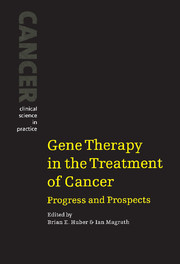Book contents
- Frontmatter
- Contents
- Contributors
- Preface
- 1 Introduction: gene therapy approaches to cancer
- 2 Principles of transformation-directed cancer therapy
- 3 Vectors for cancer gene therapy
- 4 Genetically engineering drug sensitivity and drug resistance for the treatment of cancer
- 5 Oncogene inactivation and replacement strategies for cancer
- 6 Genetically modified tumor cells as tumor vaccines
- 7 Genetically modified lymphocytes and hematopoietic stem cells as therapeutic vehicles
- 8 Pharmacologic effects of oligonucleotides and some clinical applications
- 9 Current status of gene marking and gene therapy in oncology clinical trials
- 10 Safety testing for gene therapy products
- Index
6 - Genetically modified tumor cells as tumor vaccines
Published online by Cambridge University Press: 01 April 2010
- Frontmatter
- Contents
- Contributors
- Preface
- 1 Introduction: gene therapy approaches to cancer
- 2 Principles of transformation-directed cancer therapy
- 3 Vectors for cancer gene therapy
- 4 Genetically engineering drug sensitivity and drug resistance for the treatment of cancer
- 5 Oncogene inactivation and replacement strategies for cancer
- 6 Genetically modified tumor cells as tumor vaccines
- 7 Genetically modified lymphocytes and hematopoietic stem cells as therapeutic vehicles
- 8 Pharmacologic effects of oligonucleotides and some clinical applications
- 9 Current status of gene marking and gene therapy in oncology clinical trials
- 10 Safety testing for gene therapy products
- Index
Summary
Introduction
Recombinant DNA technology has allowed for the efficient introduction of defined genes into mammalian cells. Utilizing this technology, it has been feasible to express a variety of immunoregulatory proteins in tumor cells in order to modulate the host's immune response to native tumor antigens. The components of the immune response necessary to generate immunity to tumors consist of: (a) emigration of inflammatory cells to the site of tumor growth; (b) processing of tumor antigens by antigen-presenting cells; (c) sensitization of lymphoid cells; and (d) amplification and/or suppression of mature effector cells. Thus, there is a variety of avenues to modulate an immune response by specifically adding defined immune regulatory genes in this process.
Transplantable animal tumors have provided a wealth of information concerning the host antitumor immune response. Depending upon the inherent immunogenicity of the tumor, experimental methods are capable of eliciting systemic immunity to a variety of tumors in naive hosts. Many of the initial studies with genetically modified tumor cells have focused on the ability of the host to reject an inoculum of modified tumor cells, with the induction of systemic immunity to a subsequent challenge of the parental tumor. Hence, the inherent immunogenicity of the tumor being examined is important in interpreting the significance of genetic modification. Tumor immunogenicity has been traditionally defined by transplantation procedures. Table 6.1 presents the framework for discussing immunogenicity that is utilized in this chapter and is based on the ability to immunize animals to resist tumor challenge by various manipulations.
- Type
- Chapter
- Information
- Gene Therapy in the Treatment of CancerProgress and Prospects, pp. 108 - 136Publisher: Cambridge University PressPrint publication year: 1998

